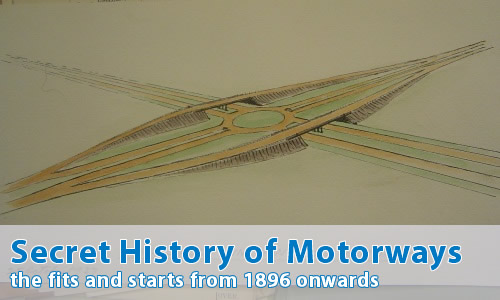Early Struggles: 1896 - 1918
1896? Are you sure?
Yes, quite sure, thanks.
Probably the first act in the motorway story in the United Kingdom (after the invention of the internal combustion engine!) came in 1896, with the Locomotives on Highways Act 1896, the need for a person to walk in front of any car in order to warn horse drawn traffic (and horse riders) of the approaching danger was repealed. In addition to that, it also changed the national speed limit from 4mph to a huge 12mph, with the ability for local authorities to vary that limit up to a maximum of 16mph at their discretion. This legislation shifted the balance away from horse power to horsepower...
Very droll.
Yes, I thought so. Took me ages to think up that pun.
Anyway, back to the story.
In 1902, the story reached Britain of planned roads in both the USA and Belgium. What set these particular plans apart was the fact that there were plans for at least part of these roads to be reserved for the use of motorised traffic. The American idea was for a road to run between New York and New Orleans, and of its 100 feet (30m) width, 20 feet (6m) of it would be solely for cars. Questions started to appear in motoring journals about why there were no such plans in Britain.
Perhaps not surprisingly, they were soon to appear, though what is surprising is that none came from the Governments of the day.
The first proposals were for a Motor Road that would run between London and Brighton, which made it as far as Parliament in 1906. "The London and Brighton Motor Way" was a Private Bill and would have provided for a motorway between Croydon and Patcham in Sussex, where co-incidentally the modern A23 dual carriageway ends and becomes the relatively unimproved road through the Brighton urban area. It would have been a dual carriageway, and only open to self-powered vehicles. As there were no other motorways planned at that time, the proposed legislation was written as if the road were a railway line, with a company that would have similar rights to railway companies. As it was a private enterprise, tolls would have been charged.
Sounds good.
Well, it wasn't.
The Bill lasted about five minutes, when it was withdrawn due to huge opposition, not only from the railway companies but also from a huge proportion of MPs, with not a single party being in favour.
As an interesting (well, it is to sad muppets like me!) aside, within the consultants' report on the M23 in the mid-1960s was a section discussing the 1906 plans, and the alternative route plans showed the 1906 route, though it was not one of the ones chosen.
I see. What's next?
A few years later (in 1910), the Roads Board came into being. This was the predecessor of the Ministry of Transport, and was funded by the Road Improvement Fund. All motoring taxes were to go to the Fund, both on the vehicles themselves and on fuel taxes. Oh, if that were the case today...
The Roads Board had the power to build roads confined to motor traffic (and that had no speed limit!), though they could allow other traffic if they desired.
The Board was an utter failure. In the nine years of its existence, it built precisely zero miles of new main roads or bridges of any major importance. Of course, for some of that time the country was busy with a small disagreement generally known as World War I, but still...

